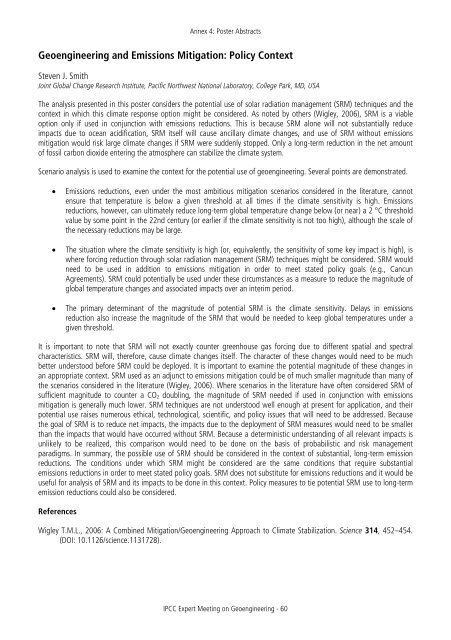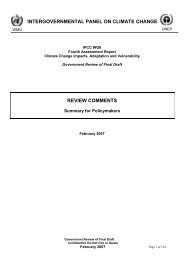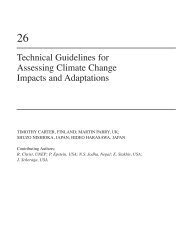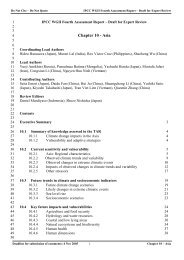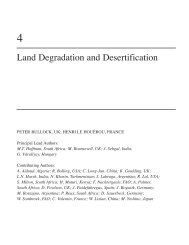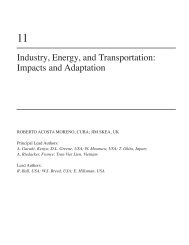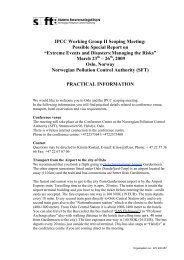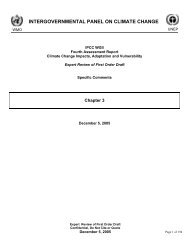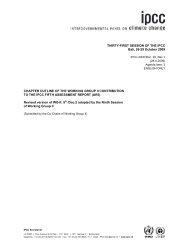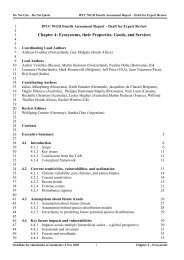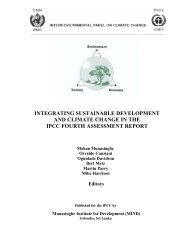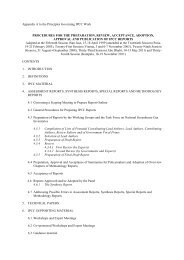IPCC Expert Meeting on Geoengineering
IPCC Expert Meeting on Geoengineering
IPCC Expert Meeting on Geoengineering
You also want an ePaper? Increase the reach of your titles
YUMPU automatically turns print PDFs into web optimized ePapers that Google loves.
Annex 4: Poster Abstracts<br />
<strong>Geoengineering</strong> and Emissi<strong>on</strong>s Mitigati<strong>on</strong>: Policy C<strong>on</strong>text<br />
Steven J. Smith<br />
Joint Global Change Research Institute, Pacific Northwest Nati<strong>on</strong>al Laboratory, College Park, MD, USA<br />
The analysis presented in this poster c<strong>on</strong>siders the potential use of solar radiati<strong>on</strong> management (SRM) techniques and the<br />
c<strong>on</strong>text in which this climate resp<strong>on</strong>se opti<strong>on</strong> might be c<strong>on</strong>sidered. As noted by others (Wigley, 2006), SRM is a viable<br />
opti<strong>on</strong> <strong>on</strong>ly if used in c<strong>on</strong>juncti<strong>on</strong> with emissi<strong>on</strong>s reducti<strong>on</strong>s. This is because SRM al<strong>on</strong>e will not substantially reduce<br />
impacts due to ocean acidificati<strong>on</strong>, SRM itself will cause ancillary climate changes, and use of SRM without emissi<strong>on</strong>s<br />
mitigati<strong>on</strong> would risk large climate changes if SRM were suddenly stopped. Only a l<strong>on</strong>g-term reducti<strong>on</strong> in the net amount<br />
of fossil carb<strong>on</strong> dioxide entering the atmosphere can stabilize the climate system.<br />
Scenario analysis is used to examine the c<strong>on</strong>text for the potential use of geoengineering. Several points are dem<strong>on</strong>strated.<br />
<br />
<br />
<br />
Emissi<strong>on</strong>s reducti<strong>on</strong>s, even under the most ambitious mitigati<strong>on</strong> scenarios c<strong>on</strong>sidered in the literature, cannot<br />
ensure that temperature is below a given threshold at all times if the climate sensitivity is high. Emissi<strong>on</strong>s<br />
reducti<strong>on</strong>s, however, can ultimately reduce l<strong>on</strong>g-term global temperature change below (or near) a 2 °C threshold<br />
value by some point in the 22nd century (or earlier if the climate sensitivity is not too high), although the scale of<br />
the necessary reducti<strong>on</strong>s may be large.<br />
The situati<strong>on</strong> where the climate sensitivity is high (or, equivalently, the sensitivity of some key impact is high), is<br />
where forcing reducti<strong>on</strong> through solar radiati<strong>on</strong> management (SRM) techniques might be c<strong>on</strong>sidered. SRM would<br />
need to be used in additi<strong>on</strong> to emissi<strong>on</strong>s mitigati<strong>on</strong> in order to meet stated policy goals (e.g., Cancun<br />
Agreements). SRM could potentially be used under these circumstances as a measure to reduce the magnitude of<br />
global temperature changes and associated impacts over an interim period.<br />
The primary determinant of the magnitude of potential SRM is the climate sensitivity. Delays in emissi<strong>on</strong>s<br />
reducti<strong>on</strong> also increase the magnitude of the SRM that would be needed to keep global temperatures under a<br />
given threshold.<br />
It is important to note that SRM will not exactly counter greenhouse gas forcing due to different spatial and spectral<br />
characteristics. SRM will, therefore, cause climate changes itself. The character of these changes would need to be much<br />
better understood before SRM could be deployed. It is important to examine the potential magnitude of these changes in<br />
an appropriate c<strong>on</strong>text. SRM used as an adjunct to emissi<strong>on</strong>s mitigati<strong>on</strong> could be of much smaller magnitude than many of<br />
the scenarios c<strong>on</strong>sidered in the literature (Wigley, 2006). Where scenarios in the literature have often c<strong>on</strong>sidered SRM of<br />
sufficient magnitude to counter a CO 2 doubling, the magnitude of SRM needed if used in c<strong>on</strong>juncti<strong>on</strong> with emissi<strong>on</strong>s<br />
mitigati<strong>on</strong> is generally much lower. SRM techniques are not understood well enough at present for applicati<strong>on</strong>, and their<br />
potential use raises numerous ethical, technological, scientific, and policy issues that will need to be addressed. Because<br />
the goal of SRM is to reduce net impacts, the impacts due to the deployment of SRM measures would need to be smaller<br />
than the impacts that would have occurred without SRM. Because a deterministic understanding of all relevant impacts is<br />
unlikely to be realized, this comparis<strong>on</strong> would need to be d<strong>on</strong>e <strong>on</strong> the basis of probabilistic and risk management<br />
paradigms. In summary, the possible use of SRM should be c<strong>on</strong>sidered in the c<strong>on</strong>text of substantial, l<strong>on</strong>g-term emissi<strong>on</strong><br />
reducti<strong>on</strong>s. The c<strong>on</strong>diti<strong>on</strong>s under which SRM might be c<strong>on</strong>sidered are the same c<strong>on</strong>diti<strong>on</strong>s that require substantial<br />
emissi<strong>on</strong>s reducti<strong>on</strong>s in order to meet stated policy goals. SRM does not substitute for emissi<strong>on</strong>s reducti<strong>on</strong>s and it would be<br />
useful for analysis of SRM and its impacts to be d<strong>on</strong>e in this c<strong>on</strong>text. Policy measures to tie potential SRM use to l<strong>on</strong>g-term<br />
emissi<strong>on</strong> reducti<strong>on</strong>s could also be c<strong>on</strong>sidered.<br />
References<br />
Wigley T.M.L., 2006: A Combined Mitigati<strong>on</strong>/<strong>Geoengineering</strong> Approach to Climate Stabilizati<strong>on</strong>. Science 314, 452–454.<br />
(DOI: 10.1126/science.1131728).<br />
<str<strong>on</strong>g>IPCC</str<strong>on</strong>g> <str<strong>on</strong>g>Expert</str<strong>on</strong>g> <str<strong>on</strong>g>Meeting</str<strong>on</strong>g> <strong>on</strong> <strong>Geoengineering</strong> - 60


